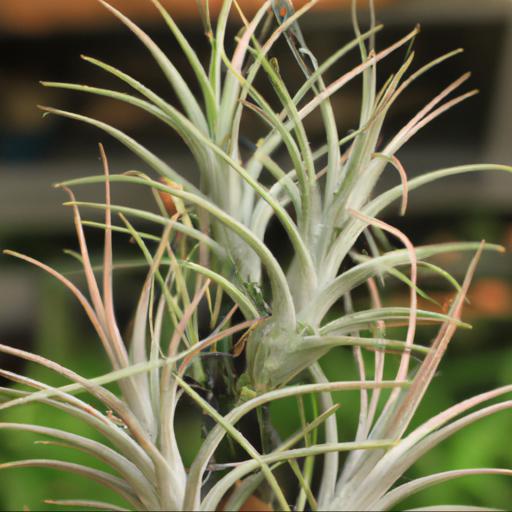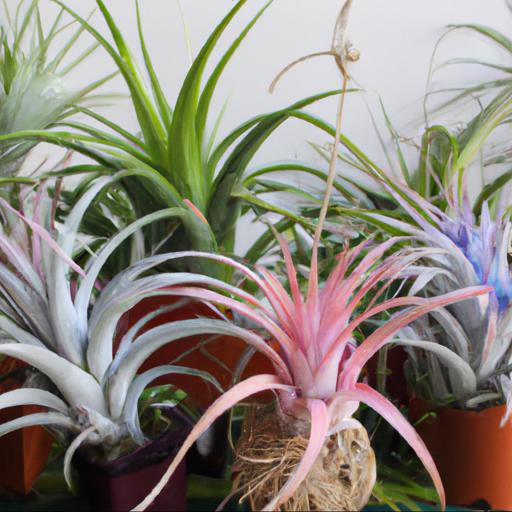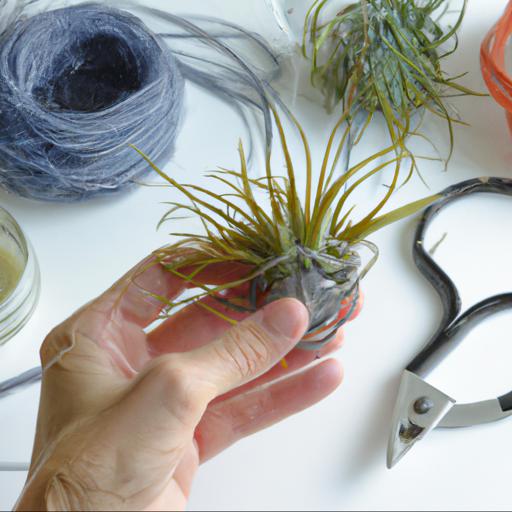Tillandsia is a type of air plant native to the tropical and subtropical regions of the Americas. They are also known as “air plants” because they don’t require soil to grow and survive. Tillandsia are popular houseplants due to their low maintenance requirements, attractive foliage, and ability to thrive in a variety of conditions.
In this blog, we will explore the unique characteristics of Tillandsia and discuss the best ways to care for them. We will also provide tips on how to propagate and display these interesting plants.
So, if you’re looking for a unique and easy-to-care-for houseplant, then Tillandsia might be the perfect choice for you!
Benefits of growing tillandsia: why should you consider growing it

Gardening experts around the world are raving about growing Tillandsia in the home and garden. With its unique look, low maintenance and sustainability, Tillandsia is the perfect choice for your green space.
Here we break down the benefits of growing Tillandsia, to give you a better insight into why it should be your go-to houseplant of choice. Tillandsia are extremely low maintenance. As they’re an epiphytic plant, they don’t need soil to grow – instead Tillandsia absorbs all of its nutrients and moisture directly from the air around it.
This makes Tillandsia a wonderful choice for those that don’t want the fuss of a complicated garden care routine. What’s more, Tillandsia need minimal amounts of sunlight, so you don’t need a spot in your home that gets direct sunlight all day long.
Just a few hours of natural light per day is enough to keep your Tillandsia happy and healthy. Tillandsia also make for a great, sustainable choice for your garden or home. Coming in all sorts of shapes, sizes and colors, nothing is lost in the process of creating these unique and beautiful plants.
With zero emissions and no running water needed, they’re the ideal option for those looking to decorate their space while doing the least amount of damage to the environment. Yet despite their small size, they pack quite a punch. Hang up a Tillandsia in any room to instantly brighten the area, without having to worry about it taking up too much space.
Finally, Tillandsia are incredibly easy to look after. All they really need is a few mistings of water when placed in a well-ventilated space, which could be as quick as a few minutes per week.
If your Tillandsia is placed in an environment with higher humidity, then you might only need to water it once a month. Even when travelling, it’s a breeze to move these plants around because there’s no soil to carry about – just hang your Tillandsia in the new spot and you’re good to go. With so many advantages to Tillandsia, it’s easy to see why it’s becoming a popular choice in homes around the world. With its low maintenance, sustainability and beautiful appearance, Tillandsia is a great addition to any space that can bring a touch of life into the home. So if you’re looking for a unique and stylish way to bring nature into your home or garden, why not consider growing Tillandsia?
Types of tillandsia: different varieties and their characteristics

Known as “Air Plants” due to their unique ability to draw moisture and nutrients directly from the atmosphere, Tillandsia plants come in many different flyways, shapes and sizes. The great thing about maintaining these plants is that they require minimal care – no soil, no watering, and no pruning. There are over 400 species of Tillandsia, each with their own distinct characteristics and environments.
Some of the most popular varieties of Tillandsia are Spanish Moss, Cotton Express, and Ball Moss. The Spanish Moss is a very versatile plant that grows in damp and humid climates.
It is characterized by its long, slender, and pendulous foliage which gives it its distinctive shape. The Cotton Express is a ground dweller, which means it grows low to the ground and is capable of clinging to rocks and other surfaces. It is a slow growing species, with small, pear-like foliage and bright yellow flowers.
The Ball Moss is an epiphyte and is common in forests and clumps in tree branches. It is characterized by its tear-shaped leaves and small, yellow/green flowers.
Overall, Tillandsia plants are an ideal choice for both beginner gardeners and experienced horticulturalists looking to add some exotic flair to their gardens. Not only are they easy to care for and adaptable to a wide range of climates, they can also provide a stunning and unique display of flora that will no doubt draw the attention of visitors and the envy of your neighbours.
Care and maintenance of tillandsia: how to keep it healthy and happy

Keeping your Tillandsia air plants healthy and happy requires a unique balance of sunlight, water and air circulation. As ‘air plants’ imply, Tillandsia are well-suited to growing without soil, and they take in the majority of their nutrients through their leaves.
With proper care, they can thrive indoors and can have an indefinite lifespan. When it comes to keeping Tillandsia healthy, the most important factor is light exposure. Being native to the Americas, these plants need indirect, plentiful sunlight to support their growth.
An easy way to give your Tillandsia access to sunlight is to place it near an east or south-facing window. Make sure that the leaves don’t touch the window to avoid sunburn.
Alternatively, you can hang them on a wall protected from direct sunlight. Too much light will cause the leaves to become dry and brown, and the plants may not last that long. In terms of watering and air circulation, Tillandsia require frequent misting two to three times a week.
As a general rule of thumb, if the leaves look dry, mist them a little. Additionally, it’s important to soak the plant every two weeks in a bowl of water to ensure it absorbs enough hydration. After soaking, gently shake off excess water to ensure the leaves do not rot, and pat the leaves dry with a cloth.
Providing air circulation is also important for Tillandsia, so make sure to keep it away from heaters and close windows. Overall, Tillandsia is an alluring species of air plants that can bring life to any interior space.
With the right balance of sunlight, water, and air circulation, you can keep your Tillandsia looking healthy and happy for years to come.
Creative ways to display tillandsia: get creative with your plant decor!
When it comes to introducing a classic and modern touch to your home decor, Tillandsia can offer the perfect balance of air-purifying plants, along with aesthetic charm. Tillandsia, also known as air plants, are incredibly low maintenance, as they do not require soil or regular watering. They absorb moisture through their leaves and take nutrients from the air.
With their low maintenance care and beautiful, sculptural form and colors, Tillandsia can create a fine display to your home or garden. One of the interesting ways to display your collection of Tillandsias is to create an indoor or outdoor terrarium with a tall glass or plastic container.
Simply fill the container with sand, stones, or decorative pieces as a base before placing some of your Tillandsia in the centre. Ensure the lid is secure to create a humid environment inside and enhance the aesthetics of your Tillandsia. This enclosed terrarium would make the perfect captivating feature in your home.
If you have a vivid collection of Tillandsia, consider growing them on a branch that can be hung on the wall. This is a very creative and modern way of displaying your plants while adding a playful vibe to the room.
Tie the Tillandsia with strips of cloth or fibers to the branch and hang it securely against the wall. Install a bright spotlight near the branch to create a unique display.
Tillandsias mounted on driftwood or branches is an eclectic way of creating indoor wall gardens. The addition of festive lights and simple decorations will add an eye-catching touch to the entire display. There are so many creative options when it comes to displaying your Tillandsia indoor and outdoors.
With a little imagination and a few well-chosen accessories, you can create a visually engaging atmosphere in your home while helping purify the air with Tillandsia.
Bottom Line
Tillandsia is a genus of over 650 species of evergreen, perennial flowering plants in the family Bromeliaceae. They are native to the forests, mountains and deserts of Central and South America. Tillandsia are epiphytes, meaning they grow without soil, instead clinging to trees and other surfaces.
They are known for their unique ability to absorb water and nutrients through their leaves, making them a popular choice for terrariums and other creative displays.
FAQ
What is the scientific name of Tillandsia?
The scientific name of Tillandsia is Tillandsia spp.
What are the common uses of Tillandsia?
The common uses of Tillandsia, also known as air plants, include decoration, air purification, and as a food source for certain animals.
How often should Tillandsia be watered?
Tillandsia should be watered about once a week, or when the leaves feel dry to the touch.
What type of environment does Tillandsia prefer?
Tillandsia prefers a warm, humid environment with plenty of air circulation and indirect sunlight.
How do you propagate Tillandsia?
Tillandsia can be propagated by division, cuttings, or offsets. Division involves separating the plant into two or more sections, each with its own root system. Cuttings involve cutting a piece of the plant off and planting it in a new pot. Offsets are small plantlets that form on the mother plant and can be removed and planted in a new pot.
What are the benefits of growing Tillandsia?
The benefits of growing Tillandsia include their low maintenance requirements, their ability to thrive in a variety of climates, their air-purifying properties, and their attractive foliage.

